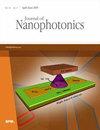深度学习有助于同时发现结构-材料设计:相变材料元表面设计的案例研究
IF 1.1
4区 物理与天体物理
Q4 NANOSCIENCE & NANOTECHNOLOGY
引用次数: 1
摘要
摘要现代精密纳米制造的能力和材料的广泛选择[等离子体金属、高折射率电介质、相变材料(PCM)和2D材料]使超表面等纳米光子结构的逆向设计变得越来越困难。深度学习在纳米光子学逆向设计中越来越重要。尽管深度学习设计方法越来越复杂,但结构和材料的同时逆向设计问题并没有得到太多关注。在这篇文章中,我们提出了一种基于深度学习的逆向设计方法,用于同时进行材料选择和器件几何优化。为了证明所提出的方法的实用性,我们考虑了使用PCM的主动元表面设计的主题问题。我们考虑了一组四种常用的相变材料,它们都处于完全非晶和结晶的材料相中,用于材料选择,以及用于几何部分的任意指定的多边形间原子形状,这导致了巨大的结构/材料设计空间。我们发现,设计合适的深度神经网络可以在充足的设计空间内实现良好的光谱预测能力。此外,我们表明,该正向模型具有足够高的预测能力,可用于替代优化设置,从而实现可切换功能的主动元表面的逆向设计。本文章由计算机程序翻译,如有差异,请以英文原文为准。
Deep learning aids simultaneous structure–material design discovery: a case study on designing phase change material metasurfaces
Abstract. The capabilities of modern precision nanofabrication and the wide choice of materials [plasmonic metals, high-index dielectrics, phase change materials (PCM), and 2D materials] make the inverse design of nanophotonic structures such as metasurfaces increasingly difficult. Deep learning is becoming increasingly relevant for nanophotonics inverse design. Although deep learning design methodologies are becoming increasingly sophisticated, the problem of the simultaneous inverse design of structure and material has not received much attention. In this contribution, we propose a deep learning-based inverse design methodology for simultaneous material choice and device geometry optimization. To demonstrate the utility of the proposed method, we consider the topical problem of active metasurface design using PCMs. We consider a set of four commonly used PCMs in both fully amorphous and crystalline material phases for the material choice and an arbitrarily specifiable polygonal meta-atom shape for the geometry part, which leads to a vast structure/material design space. We find that a suitably designed deep neural network can achieve good optical spectrum prediction capability in an ample design space. Furthermore, we show that this forward model has a sufficiently high predictive ability to be used in a surrogate-optimization setup resulting in the inverse design of active metasurfaces of switchable functionality.
求助全文
通过发布文献求助,成功后即可免费获取论文全文。
去求助
来源期刊

Journal of Nanophotonics
工程技术-光学
CiteScore
2.60
自引率
6.70%
发文量
42
审稿时长
3 months
期刊介绍:
The Journal of Nanophotonics publishes peer-reviewed papers focusing on the fabrication and application of nanostructures that facilitate the generation, propagation, manipulation, and detection of light from the infrared to the ultraviolet regimes.
 求助内容:
求助内容: 应助结果提醒方式:
应助结果提醒方式:


